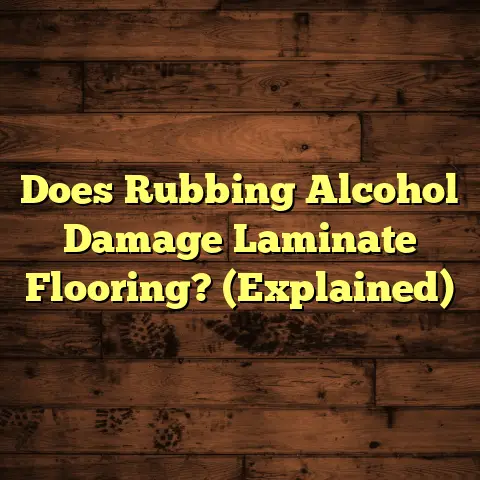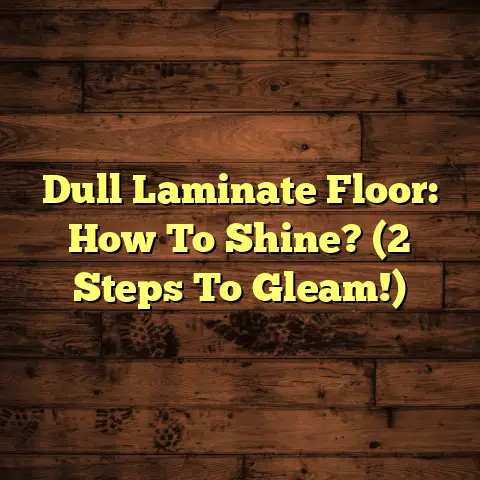How To Paint Over A Vinyl Tile Floor? (Explained)
Have you ever looked at your outdated vinyl tile floor and thought, “I wish it could look like new again?” I certainly have, and I’m here to tell you that painting over vinyl tiles is a viable option to refresh your space without undergoing a complete renovation. The transformation can be remarkable, and with the right approach, you can achieve a beautiful finish that lasts.
What is Painting Over Vinyl Tile?
Painting over vinyl tile involves applying a specialized paint designed to adhere to the tile surface, allowing you to change the color and finish without replacing the tiles. This method can be a cost-effective solution for transforming a room’s appearance. Often, homeowners underestimate the potential of their existing floors, thinking replacement is the only way forward. However, with some creativity and effort, you can breathe new life into your floors.
Why Consider Painting Vinyl Tiles?
Vinyl tiles are often chosen for their affordability and ease of installation. However, over time, they can become dull, stained, or outdated in style. Here are several reasons why painting over vinyl tiles can be a great choice:
- Cost-Effective: Replacing flooring can be expensive. Painting offers a budget-friendly alternative to achieve a fresh look.
- Quick Transformation: Compared to full floor replacement, painting can be completed in days rather than weeks.
- Customization: You can choose any color or finish to match your home’s decor.
- Sustainability: Instead of discarding old tiles, painting allows you to reuse them, reducing waste.
My Experience with FloorTally
Before starting my project, I turned to FloorTally, a tool that has become invaluable in my flooring business. It helped me estimate the costs associated with painting my vinyl floor accurately. By inputting measurements and material choices, I could see realistic budgets and timelines, which made planning much easier. FloorTally also allowed me to visualize the project scope, helping me understand how much paint and primer I needed to purchase.
Preparing for the Project
Choosing the Right Paint
I began by researching the best paint options for vinyl tiles. After some thorough investigation, I decided on a high-quality epoxy floor paint. This choice was based on its durability and resistance to wear and tear, which is crucial for flooring. The epoxy paint forms a hard protective layer that can withstand foot traffic without chipping or peeling.
- Cost of Paint: I purchased one gallon of paint for about $45—this seemed reasonable considering the transformation I was about to undertake. Brands like Rust-Oleum and Behr offer reliable epoxy paints suitable for vinyl surfaces.
Surface Preparation
Preparation is key when painting any surface, especially vinyl tiles. I spent a few hours cleaning the floor with a mixture of vinegar and water to remove any grime or residue. After drying, I lightly sanded the tiles to ensure better paint adhesion. This process took about an hour but was essential for achieving a smooth finish.
- Tools Needed:
- Broom and mop for cleaning
- Sandpaper (medium grit) for scuffing the surface
- Painter’s tape to protect edges
- Roller and brushes for application
- Primer specifically for vinyl surfaces
The Painting Process
Priming the Tiles
Next, I applied a primer specifically formulated for vinyl surfaces. This step is non-negotiable as it creates a good bond between the paint and the vinyl. I used a roller for the large areas and a brush for the edges and corners. The primer dried in about two hours, allowing me to move quickly to the next phase.
- Why Priming Matters: Primer helps ensure that the paint adheres properly and provides an even base for color application. It also enhances durability by preventing peeling in the future.
Applying the Paint
Once the primer was set, I started painting with my chosen epoxy paint. I opted for a light gray color to brighten up my small kitchen. The first coat went on smoothly, but I realized that I needed two coats for full coverage. Each coat took about three hours to dry completely. After the second coat, I was thrilled with how vibrant the color looked.
- Application Technique:
- Start at one corner of the room and work your way out to avoid stepping on freshly painted areas.
- Use long, even strokes with a roller for large areas.
- Apply paint with a brush around edges and in corners where the roller cannot reach.
Challenges Encountered
One of the main challenges I faced was ensuring even coverage, especially in high-traffic areas. During my first attempt at painting a section, I noticed that certain spots appeared darker due to uneven application. To avoid this, I learned to work in smaller sections and maintain a wet edge as I painted.
- Tip for Avoiding Dark Spots: To ensure even coverage, always keep a wet edge by overlapping slightly with each stroke before the paint dries.
Post-Painting Care
Curing Time
After waiting 72 hours for the paint to cure, I moved furniture back into place and began using the kitchen as usual. Regular sweeping and occasional mopping with a gentle cleaner helped maintain the new look of the floor. So far, it has held up well against daily wear and tear.
- Curing vs. Drying: It’s crucial to understand that curing time is different from drying time. While paint may feel dry to the touch after a few hours, it takes longer for it to fully harden.
Maintenance Tips
To keep my newly painted vinyl tiles looking fresh, I’ve implemented a regular maintenance routine:
- Regular Cleaning: Sweep or vacuum regularly to remove dirt and debris that can scratch the surface.
- Gentle Cleaning Solutions: Use mild detergents or vinegar solutions instead of harsh chemicals that can damage the paint.
- Avoid Excessive Water: Vinyl tiles can warp if exposed to too much moisture; use damp mops rather than soaking wet ones.
Successes from My Experience
The results exceeded my expectations! The kitchen felt brighter and more inviting with the new color scheme. Friends and family were impressed when they visited and saw how well the painted floor transformed the space.
- Cost Savings: The total cost of materials (paint, primer, tools) came in at around $150—far less than what new flooring would have cost.
Tips for Others Considering This Project
- Test First: Always test your paint choice on a small, inconspicuous area of the tile before committing.
- Use Quality Products: Invest in high-quality paint and primer for better results.
- Take Your Time: Rushing through the painting process can lead to mistakes; patience pays off!
- Consider Your Environment: Ensure you have proper ventilation during application—open windows or use fans to help with airflow.
Comparing Different Approaches
Painting vs. Replacement
When considering whether to paint or replace vinyl tiles, several factors come into play:
- Cost: Painting is significantly cheaper than replacing flooring.
- Time: Painting can often be completed in just a weekend, while replacement may involve multiple days of removal and installation.
- Customization: Painting allows for unique colors and patterns that may not be available in pre-made tiles.
Alternatives to Painting
In addition to paint, there are other methods to update vinyl flooring:
- Vinyl Plank Flooring: A more modern take on vinyl that offers various styles.
- Peel-and-Stick Tiles: An easy DIY option that requires no adhesive but may not last as long as painted floors.
- Area Rugs: If full coverage isn’t desired, strategically placed area rugs can help hide older flooring while adding character.
Technical Specifications of Vinyl Painting
Understanding some technical aspects can enhance your project outcome:
- Epoxy Paint Composition: Epoxy floor paints typically consist of resin and hardener components that chemically bond to form a durable surface.
- Drying Times: Most epoxy paints require at least 24 hours before light foot traffic is allowed; full strength may take up to seven days.
- Adhesion Properties: The right primer promotes adhesion by filling in microscopic pores on the vinyl surface.
Potential Disadvantages
While painting over vinyl tile has many advantages, it’s important to consider potential drawbacks:
- Durability: While epoxy paints are tough, they may not hold up indefinitely under heavy wear—especially in high-traffic areas.
- Repairability: If damage occurs (scratches or chips), repairing painted floors can be more complicated than replacing tiles.
- Change of Mind: If you decide you want a different look later on, stripping paint from vinyl can be challenging.
Conclusion
Painting over vinyl tiles can be an affordable and effective way to refresh your space. While it does come with its challenges—like achieving even coverage and ensuring proper preparation—the rewards are well worth it. With tools like FloorTally at my disposal for accurate budgeting and project management, I feel equipped to tackle such projects confidently.
In comparison to other solutions like replacing tiles or installing new flooring altogether, painting offers a quick turnaround and minimal disruption while still achieving impressive results. So if you’re considering giving your vinyl tile floor a facelift, don’t hesitate—grab that paintbrush and start transforming your space!
As someone who has successfully completed this project, I encourage others not to overlook their existing flooring but rather explore creative solutions like painting. The possibilities are endless, and with patience and careful execution, you too can achieve stunning results on your own vinyl tile floors.





